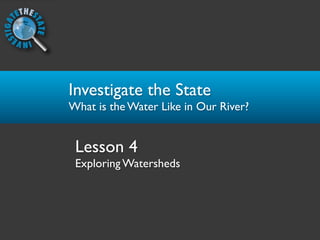
Explore Watersheds Through Models
- 1. Investigate the State What is the Water Like in Our River? Lesson 4 Exploring Watersheds
- 2. Learning Set 2 - Lesson 4 Where Is Our River Located? Focus of the Day: Exploring Watersheds In small groups, students create a watershed model and then make observations during the testing of it. Through this an initial understanding of watersheds and their characteristics is gained.
- 3. Learning Objectives and Purpose • By collaboratively building and testing a watershed model, students are able to explain how water flows through a watershed, and the characteristics of a watershed.
- 4. Overview of Activities • Introduction of the term “watershed” and the concept of “modeling”. • Discuss the word watershed and how it may relate to the Driving Question. • Facilitate a discussion around examples of models, the benefits and limitations of model use, and the types of models that will be used in this activity. • Building of Watershed • Student groups follow step-by-step directions. • Creation of Elevation Map • Students create maps of their watersheds
- 5. Overview of Activities (cont.) • Predicting Water Flow • Students record predictions that include explanations. • Observations and Testing of Models • Students test their models and make detailed observation notes to use in explaining the models.
- 6. Overview of Activities (cont.) • Relating Models to Real World • Comparisons are made between parts of student models and parts of a real river system. • River System Hydrology • Students use knowledge gained from the models to understand runoff, absorption, groundwater, and water flow based on elevation.
- 7. Student Actions • In small groups, students build a watershed model. • An elevation map is created by students to reflect their watershed model. • Students write predictions about water flow within their watershed model. • Testing of models occurs with students noting detailed observations. • Students compare their watershed models to a real river system.
- 8. Teacher Considerations • Supplies need to be gathered for the construction of the watershed models. • If you haven’t used this type of watershed model before, it is highly recommended that you create and test one of the models to analyze materials and to become comfortable with how the model works. • Make copies of Student Worksheets: • What is a Watershed? • Elevation/Observation Map • What Happens to the Water When it Rains? • What Direction Does the Water Flow?
- 9. Lesson 4 Assessment • Students work effectively as members of a small group to build and test a watershed model while also completing individual maps, predictions, observations and explanations. • Students are able to identify the parts of the watershed model and relate observations made during testing to real world structures and phenomena. • Students accurately define and describe key vocabulary and concepts. (runoff, absorption, groundwater, slope, watershed, water flow)
- 10. Preparation for Next Lesson: Where Is My River Located? • The next lesson deals with analyzing maps. • Read through Student Reader/Where is my River Located? (Learning Set 2, Lesson 5) and decide when and how you would like the students to complete it. • Read through lesson five in the teacher materials and copy the student worksheets/maps: Major Watersheds of Michigan and the Great Lakes Topographic Map. • If not familiar with topographic maps and their use, please see the website: www.
- 11. For More Information • Review the curriculum guide: “What is the Water Like in Our River?” • Visit our web site: http://www.investigatethestate.org
Hinweis der Redaktion
- Building a watershed will help students observe and directly interact with aspects of watersheds that may otherwise be difficult to comprehend.
- Students will make observations during the testing of their watershed. This gives them the ability to explain, with evidence, how and why water flows, branches and pools as it does on their model. They also create a map to represent these features and gain an initial experience with topography and its effect on water flow.
- While building a model of a watershed, students are able to learn about two types of models. (Physical - 3-D models, and 2 dimensional representations of the same information) Discussing the benefits and challenges of these models, deepens students’ conceptualization of the features they encounter during the investigations in this unit.
- When students write about their predictions for water flow within their models, they are guided to include explanations that show evidence for their reasoning. Then, when testing the models, their observations either support or refute those predictions with new explanations being generated as to why. This cycle helps students see the necessity for close observation and providing evidence when conducting scientific investigations.
- After building and testing their models, students can more readily see and understand how river systems function. This then helps them build their understanding of terminology used in hydrology studies such as, runoff, absorption, groundwater, and water flow.
- As noted in the previous slides, students move from model building and creation of an elevation map, to testing and then reflecting on the relationship between their models and actual river systems.
- Watch the Watershed Model video on the website to see suggestions and procedures for this activity. Making the model for oneself is also very useful in being prepared for student questions and challenges.
